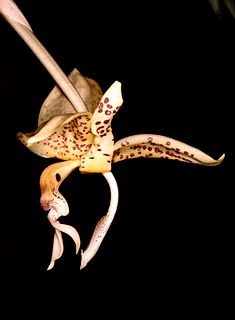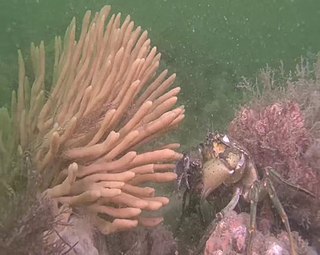Related Research Articles

The smoothback angelshark is an angelshark of the family Squatinidae found in the eastern Atlantic.

Pheidole oculata is a species of ant in the subfamily Myrmicinae. It is endemic to Madagascar.

Verticordia oculata is a flowering plant in the myrtle family, Myrtaceae and is endemic to Western Australia. It is a sprawling woody shrub with large, circular leaves with white edges and silver-white flowers with a dark centre of lilac and purple, the largest flowers of the genus Verticordia. The botanist Ferdinand von Mueller reportedly became entranced by its floral display when he visited the northern sandplains area in 1877, later describing the shrub as the 'princess of Australian flora'.

Stanhopea oculata is a species of orchid occurring from Mexico to Colombia and southeastern Brazil.

Madrepora oculata, also called zigzag coral, is a stony coral that is found worldwide outside of the polar regions, growing in deep water at depths of 80–1500 meters. It was first described by Carl Linnaeus in his landmark 1758 10th edition of Systema Naturae. It is one of only 12 species of coral that are found worldwide, including in Subantarctic oceans. In some areas, such as in the Mediterranean Sea and the North-east Atlantic Ocean, it dominates communities of coral.

Molgula oculata, commonly known as the sea grape, is a species of solitary tunicate in the family Molgulidae. It is native to the north eastern Atlantic Ocean and the North Sea. The specific name oculata means "having eyes"; the species has orifices which "seem like dark eyes within a spectacle-formed frame".
Afropone is an extinct genus of ant in the formicid subfamily Ponerinae, and is currently unplaced in any of the tribes of that subfamily. The genus contains two described species, Afropone oculata and Afropone (?) orapa. Afropone is known from a group of Upper Cretaceous fossils, which were found at Orapa in the Central District of Botswana.
Dioithona oculata is a species of small crustacean, a marine copepod in the order Cyclopoida. It is native to the Indo-Pacific region but has spread to other parts of the world. It is a free-swimming epipelagic species found near the surface of the water. It was first described as Oithona oculata by the Irish zoologist George Philip Farran in 1913.
Ischnolea inexpectata is a species of beetle in the family Cerambycidae. It was described by Galileo and Martins in 1993. It is known from Brazil.
Ischnolea modesta is a species of beetle in the family Cerambycidae. It was described by Galileo and Martins in 1993. It is known from Brazil.
Ischnolea bicolorata is a species of beetle in the family Cerambycidae. It was described by Galileo and Martins in 2007. It is known from Bolivia.
Ischnolea flavofemorata is a species of beetle in the family Cerambycidae. It was described by Breuning in 1943. It is known from Brazil.
Ischnolea peruana is a species of beetle in the family Cerambycidae. It was described by Breuning in 1943. It is known from Peru.
Ischnolea spinipennis is a species of beetle in the family Cerambycidae. It was described by Breuning in 1943. It is known from Brazil.
Ischnolea longeantennata is a species of beetle in the family Cerambycidae. It was described by Breuning in 1942. It is known from Brazil.
Ischnolea strandi is a species of beetle in the family Cerambycidae. It was described by Breuning in 1942. It is known from Brazil.
Ischnolea crinita is a species of beetle in the family Cerambycidae. It was described by Thomson in 1860. It is known from Brazil and Ecuador.
Ischnolea odettae is a species of beetle in the family Cerambycidae. It was described by Martins, Galileo and Tavakilian in 2008. It is known from French Guiana.

Haliclona oculata, sometimes known by the common name mermaid’s glove, is a species of sea sponges that is found in depths from 4m to approx 1,000 m.
Henricia oculata, commonly known as the bloody Henry starfish, is a species of starfish in the family Echinasteridae. It is native to northwestern Europe. It was first described as Asterias oculata by the British zoologist Thomas Pennant in 1777, later being transferred to the genus Henricia.
References
- ↑ BioLib.cz - Ischnolea oculata. Retrieved on 8 September 2014.